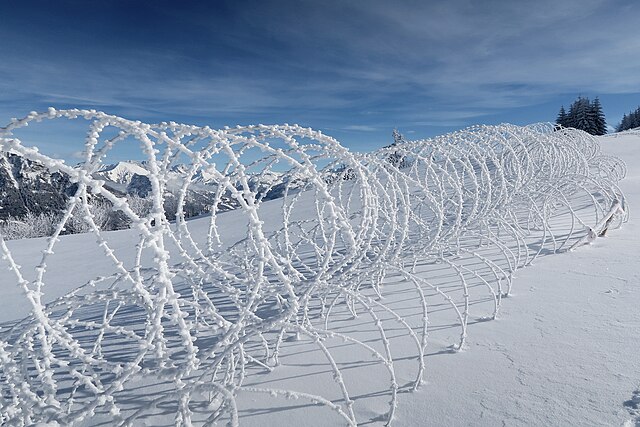The cheval de frise was a defensive obstacle, existing in a number of forms, principally as a static anti-cavalry obstacle but also quickly movable to close breaches. The term was also applied to underwater constructions used to prevent the passage of ships or other vessels on rivers. In the anti-cavalry role the cheval de frise typically comprised a portable frame with many projecting spikes. Wire obstacles ultimately made this type of device obsolete.
A Confederate cheval de frise at the Fort Mahone defenses during the siege of Petersburg
The "knife rest" or "Spanish rider" is a modern wire obstacle functionally similar to the cheval de frise, and sometimes called that.
Chevaux de frise, according to the later use of the term, could include broken glass studding the top of a wall in a nineteenth-century fort.
Outline showing the structure of a Cheval de frise for river use: Illustration A: Side view; Illustration B: Top view
In the military science of fortification, wire obstacles are defensive obstacles made from barbed wire, barbed tape or concertina wire. They are designed to disrupt, delay and generally slow down an attacking enemy. During the time that the attackers are slowed by the wire obstacle they are easy to target with machine gun and artillery fire. Depending on the requirements and available resources, wire obstacles may range from a simple barbed wire fence in front of a defensive position, to elaborate patterns of fences, concertinas, "dragon's teeth" and minefields hundreds of metres thick.
A snow-covered obstacle with concertina wire
Juno Beach on D-Day, 1944. The barbed wire fence is crude and not very high. However, when combined with the steep, curving sea wall it slows down any attacker, giving time for a nearby machinegun bunker (visible on the far left) to sweep the area with enfilade fire. Note the soldier in the background, forced to use a ladder.
A complex obstacle belt of low wire entanglement backed by a double apron fence. Both obstacles have movable openings that can be blocked with knife rests.
The deadly result of enfilade fire during the Dieppe Raid of 1942: dead Canadian soldiers lie where they fell. Trapped between the beach and fortified sea wall (covered with barbed wire), they made easy targets for MG 34 machineguns in a German bunker. The bunker firing slit is visible in the distance, just above the German soldier's head.








